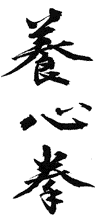
| Seminar in Stockholm, 5-6 April 2014 |  Yoshinken |
||||
| This weekend seminar started with a 90 minute talk by Sensei, giving instructions in something not visible by the naked eye. Repetition of basics and a deeper understanding of the fundamental parts of our training was in focus, especially Ritsu zen. On many occasions we have been told Ritsu zen should be included in everything we do, but maybe not fully grasped it. As we ended the training on Sunday, in a strong standing position with a flexible upper body and a bokken in our grasp, we had walked the full circle in our understanding of how everything relates to each other in Yoshinken. We started out with Ritsu zen; recapitulating the five mandatory items included in our personal "pre-flight check routine", prior to arriving the dojo. Entering Ritsu zen, every part of your body should be united and move as a single unit. Techniques using mental images of balloons attached under and between body limbs, internal expansion in the Hara area and correct breathing where used to get the proper feeling of the exercises. For example, you can think of a heavy tree trunk as something "living" and a boulder as something "dead". Using your eyes, you should take in the view of the complete horizon in a relaxed manner and avoid staring or focusing on a specific point or area in front of you. Meditation, a state when you may find a connection to your surroundings but you don´t necessarily react fast to changes, is not same as Ritsu zen. Ritsu zen requires you to respond fast and correct to changes in your surroundings. We where also reminded of the importance of "reaching outside of Ritsu zen".
|
As Sensei approaches, a survival instinct kicks in and many of us react by first retreating in an orderly manner and then using a technique, in two separate steps. Sensei called this a "one" and "two" response, and urged us to skip this kind of behaviour. Replace it with an immediate "two" action instead. Reacting correct to visual stimuli a couple of meters from you, will probably require some additional practice. Practice always starts with Ritsu zen, the kernel of Yoshinken. A strong, but by no means a rigid, position. Practice during Saturday afternoon included testing the Ritsu zen position. Working in pairs, a person leaned on his training partner, standing in Ritsu zen, from different angles probing for structural weakness. If you remain still and inactive in Ritsu zen when you are approached by your training partners probing hands, you will find it very difficult to keep a stable Ritsu zen. You have to meet the incoming force in time, to avoid a collapse of your Ritsu zen. It´s like a "whole body push-hands" response. Using these exercises, gave us feedback on what each person had to correct in order to get a stable Ritsu zen.
Lennart & Esko
|
||||
|
|||||
